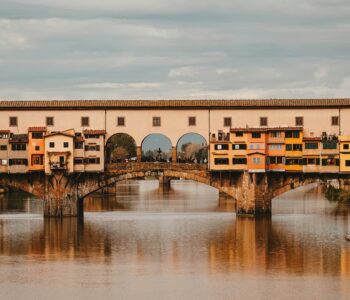
A View of the Bridge: An enduring Italian landmark offers up lessons for private wealth advisors

By Patricia M. Angus – Originally published in Trusts & Estates, August 2012
While on vacation recently in Florence, Italy, I took a stroll across the Ponte Vecchio–the aptly named oldest bridge in that city and perhaps one of the most famous bridges in the world. Not only is it well known for its long-standing duration (ancient Romans reportedly built a bridge there, followed by several replacements over the centuries), but also its image is closely tied to the shops covering it from end to end. The bridge is an outdoor market that once served as home to butchers but is now primarily filled with shops selling jewelry and souvenirs. It also hosts “Vasari’s Corridor,” built in 1565 at the behest of Cosimo I de’Medici, as a private passageway for the Medici family to travel between the Palazzo Vecchio and the Palazzo Pitti without having to interact with the public. In this second installment of the “Building Bridges” column, I explore some enduring lessons of the Ponte Vecchio and what they teach us about establishing and maintaining healthy relationships between advisors and clients.
Minimize Distance
First, the bridge is built at the narrowest point of the Arno River. There’s an important lesson to be learned from this simple fact. Too often, private wealth advisors reach out to clients or potential clients from points that are just too far a stretch to be helpful. That is, financial advisors strive to give estate-planning advice, lawyers advise on financial plans, and both stray deep into psychological issues without proper training. While starting with the best intentions to help clients, advisors who reach across these distances often find themselves going beyond their expertise and therefore become of less help than they—or their clients—hope. We must all remember the ground on which we stand and the distance we must go to be of use to a client. By acknowledging our “core expertise, we can minimize the distance between client needs and useful services and therefore have clients who are better served and satisfied.
Keep it Serious
Second, the Ponte Vecchio isn’t an especially romantic bridge. Instead, it’s built solidly on stone arches and is very much about commerce and commercial traffic. Tourists might stop to gaze at the goods on sale, but they generally don’t swoon in the way they might at the Pont Neuf in Paris or the Golden Gate in San Francisco. This is an old bridge that’s both serious in its purpose and clear about its function. In the same way, private client advisors, and our clients, must acknowledge the profound seriousness of the work that we are doing together. Nothing less than our client’s personal, financial and family welfare is at stake in our long-term planning and day-to-day transactions. From time to time, advisors and clients alike can become confused about this. Clients enjoy attending social events sponsored by their private wealth advisors, and advisors often find themselves at intimate family events such as weddings and funerals. These social interactions can be quite enjoyable, but at no time should the nature of the relationship be confused with a more romantic notion. We mustn’t lose our heads in the moment and fall to flattery in lieu of serious analytical work. An advisor who believes that a client is “family” or a “friend” risks losing objectivity and delivering less than optimal goods or services.
Maintain Private Space
Third, we must consider the lesson of Vasari’s Corridor, which can go unnoticed as one focuses on the glittering jewelry displayed across the bridge. This corridor was the family’s private lifeline, a place for them to pass through without commercial interference. Its history clearly shows the family’s intent to keep others out of this, their private space. While some advisors might gain access to a client family’s private “corridor,” they must also be careful not to set up shop within its walls. For example, a family office that confuses its role as a commercial “service provider,” akin to a shopkeeper on the bridge, may soon find access to the corridor closing shut as the family becomes leery of its motivations.
Enjoy!
Finally, we must—as I did —enjoy the stroll. If the distance isn’t too far, the bridge is solidly built, and the roles are clear, it can be quite pleasant to be on the bridge together. The time spent crossing will go quickly, and if done well and with respect, can lead to more opportunities to walk together in the future. Advisor and client alike can enjoy the view from the bridge, as well as learn and grow from their interactions as they cross it.